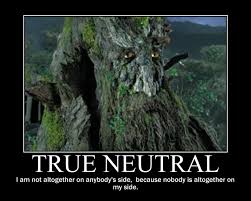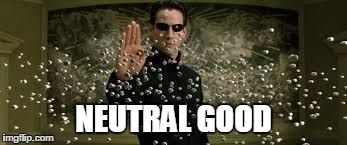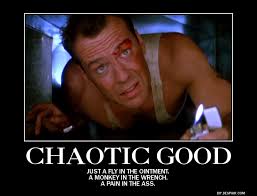More than anything else, since starting this series, I’ve learnt that alignment is highly subjective, and comments on the blog have confirmed that this is a highly contentious subject. I really wanted to show exactly how much peoples opinions can differ though, and realised that there is a very easy way to show this.
I’m an active member of several RPG facebook groups, and have had a lot of great discussions regarding alignment on them over the past few weeks. There are three groups in particular that have been quite vocal about their opinions, and I wanted to take advantage of that by asking a simple question – what alignment do you think a given character is?
It’s worth noting here that I didn’t want to influence the outcome in any way, and so didn’t vote, or comment directly on the subject other that clarify a question, or to raise an unrelated point.
I emphasised that I really wanted each persons own opinion, and came up with 4 characters whose alignment, if they were a D&D or Pathfinder character, I thought would be particularly ambiguous. I tried to to make things a little more specific if the character changed alignment during their development, as I wanted to try and create a standard that everyone could work from.
Even this proved a little difficult.
First up we looked at Jack Bauer, from 24. I love the series, and really appreciate seeing the characters reactions to being placed in difficult and stressful situations. Jack in particular is a great study, and he is unarguably working towards the common good, and puts his life on the line to protect those in danger, and yet is willing to kill anyone who gets in his way. Further, you repeatedly see him commit acts of violence, such as executing a friend, or torturing a target to get information. The community response here was very interesting.
On one hand, you had several people arguing that torture was an inherently evil act, and that action automatically put him into an evil alignment. On the other hand, it was argued that although he was committing evil acts, his alignment remained good, as he clearly showed remorse over having to do what he thought was necessary. Somewhere in the middle there was another argument suggesting that he could no longer be good, as he had committed too many evil acts.
Community result:
Total number of votes: 44 Vote winner: Chaotic Good (24 votes) Second place: True Neutral (6 votes)
Next we looked at the case for Ygritte, from Game of Thrones. She’s an interesting character, seen as both a strong, free woman, who is respected amongst the wildlings with whom she lives, and also as someone who holds strongly to her own ideals, and who respects Mance, the leader of the wildling tribes. There were some interesting discussions here, based primarily on how alignment should be viewed.
It was argued that alignment can be seen from either a social, or an absolute perspective. In terms of the absolute, it meant that an evil act is evil, no matter who is committing it. The social argument says that a persons morals (alignment) differs depending on their background, and that therefore acts that could be evil in one society are good in another. If you’re not familiar with this argument, it’s actually easy to put into context.
Think of the Aztecs. They are well known for human sacrifice as part of their religious rituals, and when viewed from an outside source (Cortez, for example), it is seen as barbaric, and evil. In their own view though, the Aztecs thought that they were doing good; those that were sacrificed seem to have often gone willingly, and some that Cortez freed seem to have demanded to be allowed to be sacrificed. Some stories indicate that the Aztecs did this in the belief that without this ritual taking place, the sun would fail to rise the next day, and so all of the peoples of the world would perish. One action, which when seen from two different cultures has very different meaning, either great evil, or great sacrifice.
In the case for Ygritte, the community was very vocal, and each group came to the same conclusion. She works for the betterment of the wildlings, because she values freedom above all else. Interestingly, we see her murder innocent families during the story, but despite this many people still saw her as essentially good.
Community result:
Total number of votes: 81 Vote winner: Chaotic Neutral (52 votes) Second place: Chaotic Good (13 votes)
When I planned this series of questions, Anakin Skywalker was one character that I felt would be reasonably simple for the community to reach a consensus on, and that we would see a very clear majority. As it happens, it was closer than I thought, although this may have been partly due to a mistake on my part.
You see, when asking the original question, I asked what alignment he would be during the period covered by Episode 2, and moving through to the point in Episode 3 where he goes batty. I completely forgot that the Clone Wars series existed, and happened entirely within the period I specified, which complicated things a bit.
There were some quite heated arguments regarding how Anakin’s alignment could be viewed. Some voted for good, others for neutral or evil. Some saw his actions as being lawful, given his loyalty to the Emperor, but others saw him as chaotic, ignoring the laws and tenets of both society and the Jedi Order. Some saw him as a villain in the making, whereas others saw him as a powerful hero, leading the Jedi cause against the evil Galactic Republic. Consequently, the vote was a lot closer than I expected.
Community result:
Total number of votes: 82 Vote winner: Chaotic Neutral (25 votes) Second place: Chaotic Good (19 votes)
It’s worth noting here that different communities reached different conclusions as well. Whereas 2 of the communities concluded that Anakin was chaotic neutral, the third decided conclusively that his alignment was either neutral good (10/26 votes) or chaotic good (18/26 votes), which I found very interesting, as this community had been the first to note the existence of the character within the Clone Wars, and was quite vocal about the characters portrayal throughout that series.
Finally we looked at Walter White, from Breaking Bad. I openly admitted that I had little knowledge of the character, having not watched the series. Of course, I know the story by now, even without having had the chance to watch it, so I had to ask the communities for their opinions on how his alignment changed through the series. This altered the question slightly, but I don’t think it changed the final outcome.
Community result:
Total number of votes: 96 Vote winner: Neutral Evil (60 votes) Second place: Chaotic Neutral (15 votes)
The decisive factor in peoples decision to vote him neutral evil was evidently his statement in the final episode, where he ‘comes clean’, and says that he did everything because he enjoyed it. What little I know of the show suggests that this could simply be showing how his character has progressed, and how much more corrupt he has become, but as I already said, my opinion doesn’t count for a lot hear – Breaking Bad is one of those many, many series that has been suggested that I watch. It’s on a long list, but I know I’ll get there, sooner or later. (If there is a particular series you think that I should watch, let me know – there’s a lot of great programmes out there, and I’m sure that I’ve missed a lot of them).
I was intending for this to be the final part on alignment, but I found the results of these votes to be interesting enough to be worthy of note in their own right. I really wanted to show how differently individuals can see the same character (and their actions), and I don’t feel that anyone differing from the majority votes above is necessarily wrong. Additionally, I believe that they are simply looking at different aspects of the character that I haven’t, and sincerely hope that you don’t feel that someone is immediately ‘wrong’ for not seeing things the same way you do.
I promise that the next article will be the last in this series, and I’ll be looking at differing ways of looking at certain gaming actions, as well as alternative alignment rules. Let me know what you think of the results of the vote, and I’ll hope to see you here again next week!
RIck.
P.S. In case you’re interested, the facebook pages I used for the purposes of the votes were ‘Dungeons & Dragons 5th Edition’, ‘Pathfinder RPG’, and ‘Pathfinder Society’. Look them up if you’re interested in those games, I’ve found some great ideas being discussed on each one.
The final votes, in case you’re interested in seeing how much variation there was, are as follows:
Jack Bauer (44 votes)
Chaotic Good – 24; True Neutral – 6; Neutral Good – 5; Chaotic Evil – 5; Neutral Evil – 2; Lawful Evil – 1; Chaotic Neutral – 1.
Ygritte (81 votes)
Chaotic Neutral – 52; Chaotic Good – 13; Neutral Good – 4; Neutral Evil – 3; Lawful Neutral – 3; True Neutral – 3; Lawful Evil – 2; Lawful Good – 1.
Anakin Skywalker (82 votes)
Chaotic Neutral – 25; Chaotic Good – 19; Neutral Good – 15; Lawful Neutral – 9; True Neutral – 6; Neutral Evil – 4; Lawful Good – 2; Lawful Evil – 2.
Walter White (96 votes)
Neutral Evil – 60; Chaotic Neutral – 15; Chaotic Good – 6; Lawful Evil – 6; Chaotic Evil – 4; Lawful Neutral – 2; True Neutral – 2; Neutral Good – 1.
Feel free to discuss these results; there’s some very interesting things here, like Walter White getting 6 votes for both chaotic good, and lawful evil.
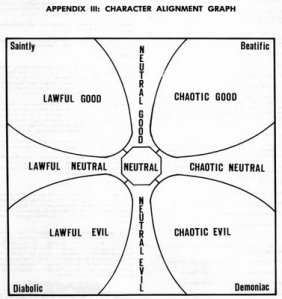
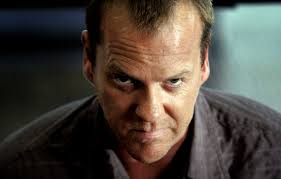


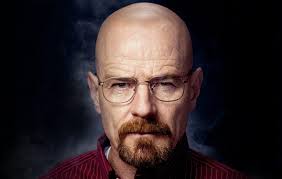
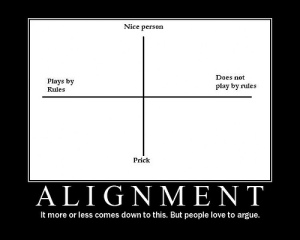
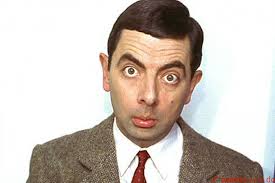
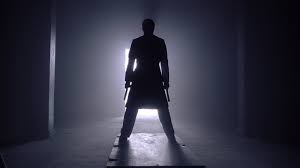


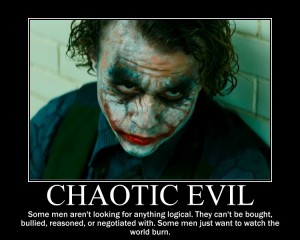
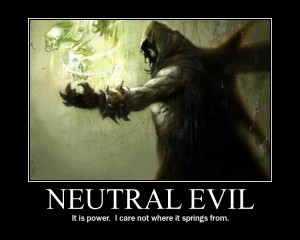
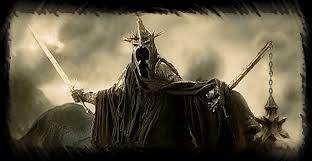
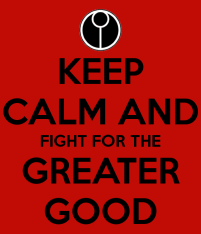 I often hear players saying something to the effect of “the ends justify the means”. Frequently, this means a player wants their goodly character to torture a creature in order to extract information, or to set fire to an annoying innkeepers livelihood. To a lawful evil character though, the ends truly do justify the means.
I often hear players saying something to the effect of “the ends justify the means”. Frequently, this means a player wants their goodly character to torture a creature in order to extract information, or to set fire to an annoying innkeepers livelihood. To a lawful evil character though, the ends truly do justify the means.


